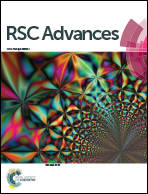Roles of both amines and acid in supramolecular hydrogel formation of tetracarboxyl acid-appended calix[4]arene gelator†
Abstract
A tetracarboxylic acid-appended calix[4]arene derivative 1 which were insoluble in water could form a supramolecular hydrogel upon addition of both amines and HCl. The added amines such as primary, secondary and tertiary amines efficiently acted as base to enhance the solubility of gelator. The stability of supramolecular gels is strongly dependent to the number of amino groups involved in the amines and the number of equivalents of amines added, relative to the equivalents of carboxylic acid groups in the calix[4]arene. In addition, the sequence of addition of both the amines and acid is critically important to form the supramolecular hydrogel from a gelator which, without any other additives, is insoluble in pure water. Furthermore, chiral gelator 1 formed a right-handed chiral arrangement of the amide chromophore in the presence of achiral amines.
![Graphical abstract: Roles of both amines and acid in supramolecular hydrogel formation of tetracarboxyl acid-appended calix[4]arene gelator](/en/Image/Get?imageInfo.ImageType=GA&imageInfo.ImageIdentifier.ManuscriptID=C5RA00685F&imageInfo.ImageIdentifier.Year=2015)

 Please wait while we load your content...
Please wait while we load your content...